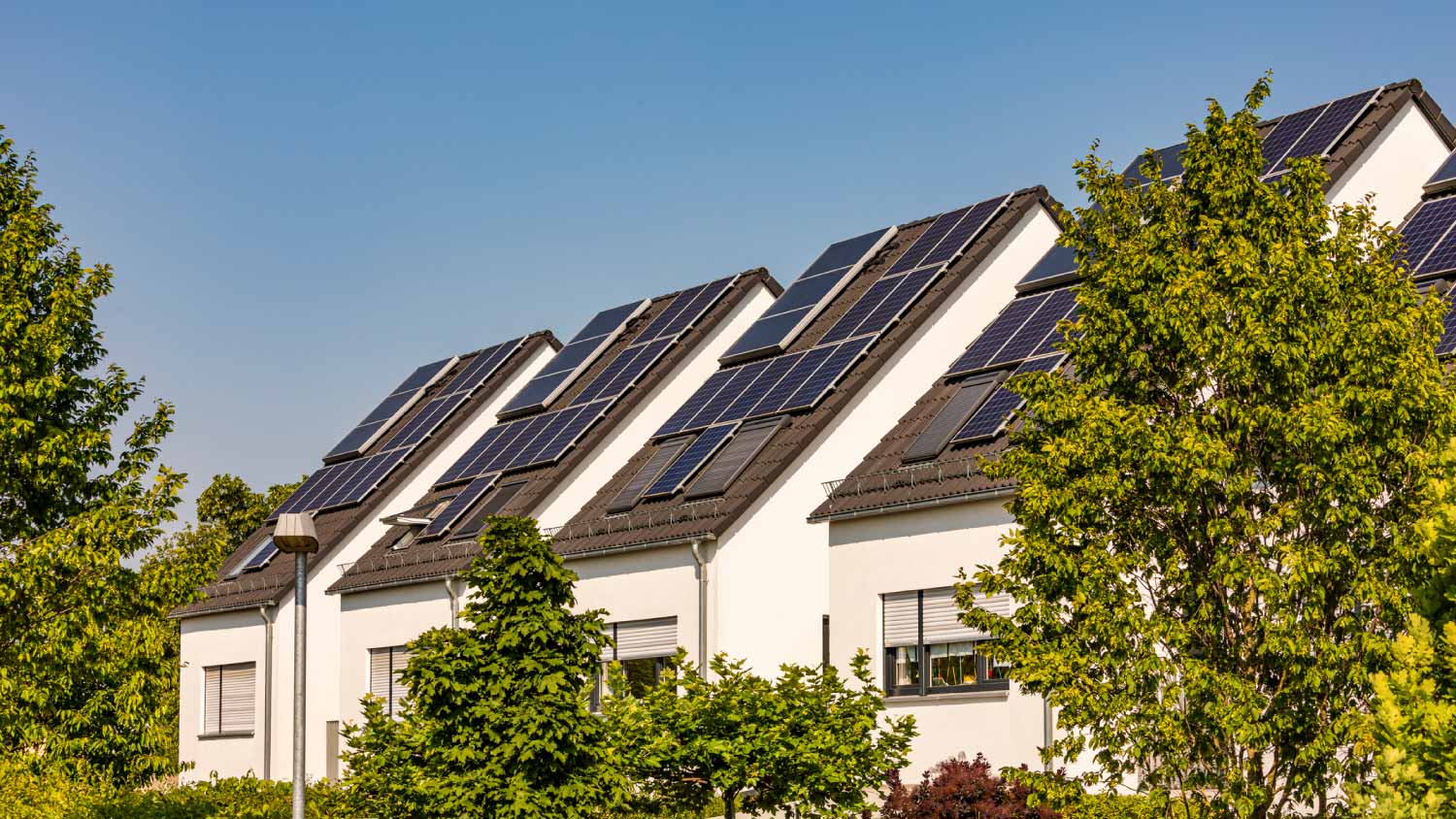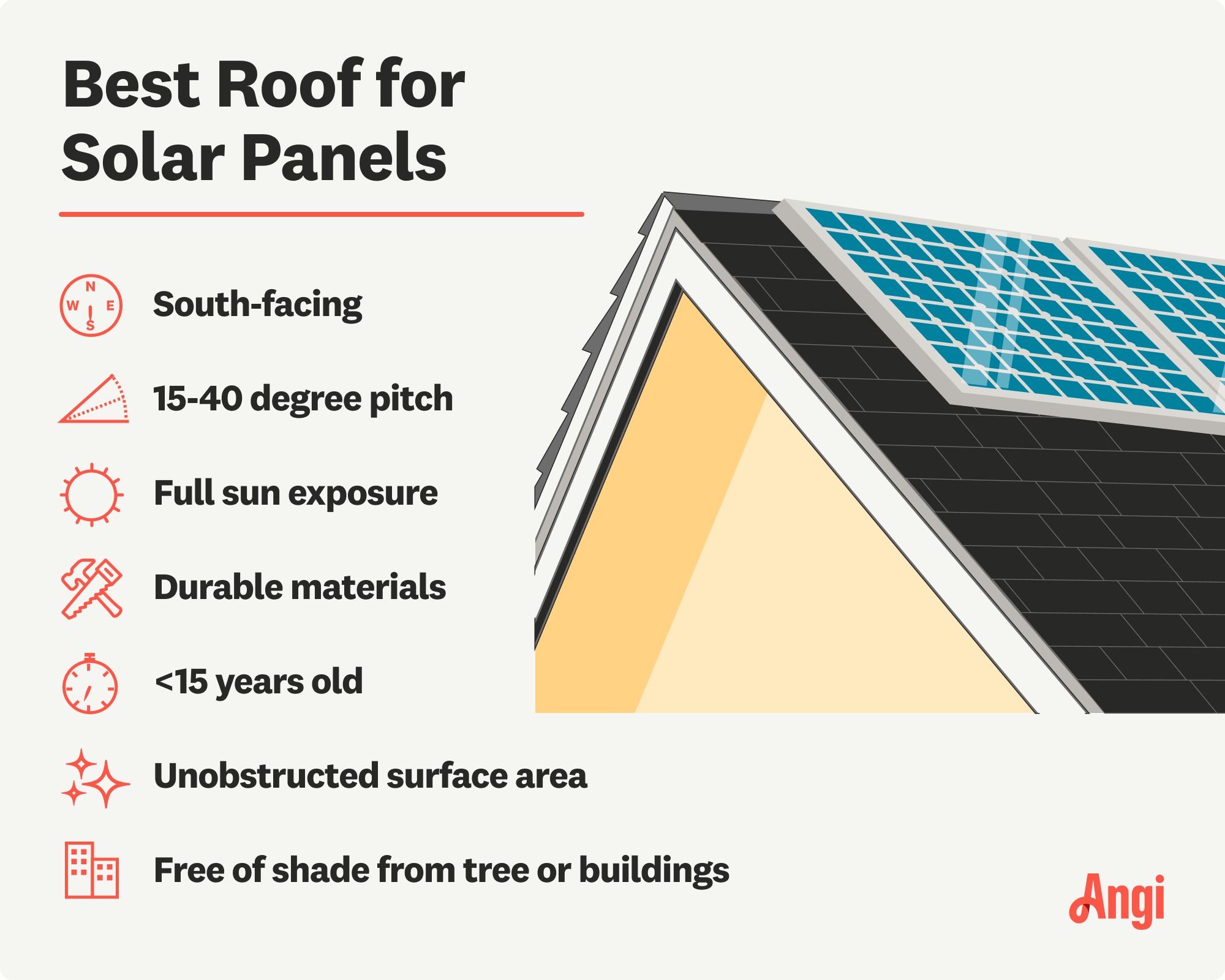What Direction Should Solar Panels Face?
Make sure your solar panels put their best face forward


Solar panels should face the equator for maximum efficiency.
In the U.S., south-facing solar panels produce the most energy.
East- or west-facing panels produce 10% to 20% less energy, and north-facing ones produce 30% less energy.
When possible, angle panels between 15 and 40 degrees.
You can mitigate lower-light installations with high-efficiency panels.
Solar energy can net you significant savings on your monthly electric bill, but solar panel efficiency is relatively low. Though it’s evolving as solar technology advances, the average residential panel only has 21% efficiency. The good news is you can make the most of your solar energy system by facing panels in the right direction. This guide will tell you everything you need to know.
Solar Panel Performance in Different Directions

Solar panels perform best when they face the equator, the direction with the most direct sunlight for the longest time. In the United States, your solar panels should face true south, but east- or west-facing panels are still a viable option. In the southern hemisphere, you’ll want to face your panels true north.
| Direction | Northern Hemisphere | Southern Hemisphere |
|---|---|---|
| South | Ideal | 30% energy loss |
| West | 10%–20% energy loss | 10%–20% energy loss |
| East | 10%–20% energy loss | 10%–20% energy loss |
| North | 30% energy loss | Ideal |
South-Facing Panels
In the northern hemisphere, south-facing solar panels produce the most energy. Any southern orientation (whether it’s slightly southwest or slightly southeast) will produce solid results as long as the panels aren’t obstructed by trees or tall buildings. In fact, you’ll only lose about 1% of your panel’s efficiency when they’re oriented 10 degrees to the east or west rather than true south.
The rule of thumb is to install solar panels so they face in the direction of the equator. This way, they receive more sunlight to power your home with solar energy. A solar panel installation pro can consider obstacles and help plan your system.
West-Facing Panels
If your roof faces west, you can still install solar panels. West-facing solar panels lose about 10% to 15% of their annual energy production—though the loss could be as high as 20% if you don’t have the right roof pitch for solar panels.
Nonetheless, you can still see significant energy savings, especially if you live in an area like California or Arizona with Time-of-Use (TOU) energy pricing plans. These plans allow energy companies to charge more for electricity used during peak hours. West-facing panels will offset these costs by producing most of their energy when electricity is most expensive.
East-Facing Panels
Like west-facing panels, east-facing solar panels produce 10% to 20% less electricity than south-facing panels. Though you can save money in a sunny area with high electricity costs, east-facing panels may not be worth the up-front expense in states with low energy costs and few solar energy incentives.
A local solar panel installer can give you more insight about what works best in your area.
North-Facing Panels
In the northern hemisphere, north-facing solar panels produce around 30% less electricity than south-facing panels. This orientation is only used as a last resort and may only be financially viable in some installations.
You can install tilt racks to help maximize the amount of sun that hits north-facing panels. In areas like Hawaii or Puerto Rico, north-facing panels fare better than in the rest of the United States.
Which Angle Is Best for Solar Panels?
The angle of your solar panels matters less than the direction, but it still impacts efficiency. For maximum energy production, south-facing solar panels should tilt between 15 and 40 degrees. East- and west-facing systems work best with a slightly shallower tilt (closer to 15 degrees than 40 degrees) as long as rain and debris can easily roll off the surface. Otherwise, dirty panels will lose efficiency.
Installing solar panels on steeper roofing is possible, but it’s a complex and time-consuming process that can significantly increase the cost of the installation.
How to Increase Efficiency if You Don’t Have a South-Facing Roof

Not every home is good for solar power. The best homes have an unshaded, south-facing roof with a 15- to 40-degree slope. The roof material must also be sturdy enough to support the system's weight. The perfect setup isn’t realistic in every situation.
If you need to face your solar panels in a different direction, there are a few things you can do to increase your solar power efficiency:
Choose monocrystalline panels: Monocrystalline panels perform better in lower-light situations than polycrystalline panels, boosting efficiency in less-than-ideal situations.
Wire parallel connections: You can install solar panels in series or in parallel. Parallel connections can mitigate the impact of shading as the sun moves.
Use a tilt rack: If your roof pitch isn’t the best for solar panels, tilt racks can help you mount them at a better angle, which is especially useful for flat roofing.
Install solar panels on the ground: If you have a north-facing roof, you can install solar panels on the ground instead. This option could be effective in sunny yards because you can orient the panels in whatever direction you want (as long as they aren’t in the shade).
Install a backup battery: If your solar panels don’t get enough sun because of occasional shade, you can install a battery to store some energy for a rainy day (literally).
Install half-cut solar panels: These panels have the dimensions of a standard solar panel but produce more energy, allowing you to use fewer panels on a smaller roof or increase your energy output in lower-light situations.
Frequently Asked Questions
In the northern hemisphere, you’ll want your solar panels to face true south. In the southern hemisphere, you’ll want your solar panels to face true north. If necessary, you can face your solar panels to the east or west, but you’ll lose anywhere from 10% to 20% of your annual energy production.
South-facing panels are still ideal in the U.S., but you can save money with east- and west-facing panels if you live where electricity costs more during peak hours. Just make sure you choose the direction that suits the peak hours outlined by your electric company. East-facing panels receive the most sunlight in the morning (early peak hours), and west-facing panels receive the most sunlight in the afternoon and evening (late peak hours).
















